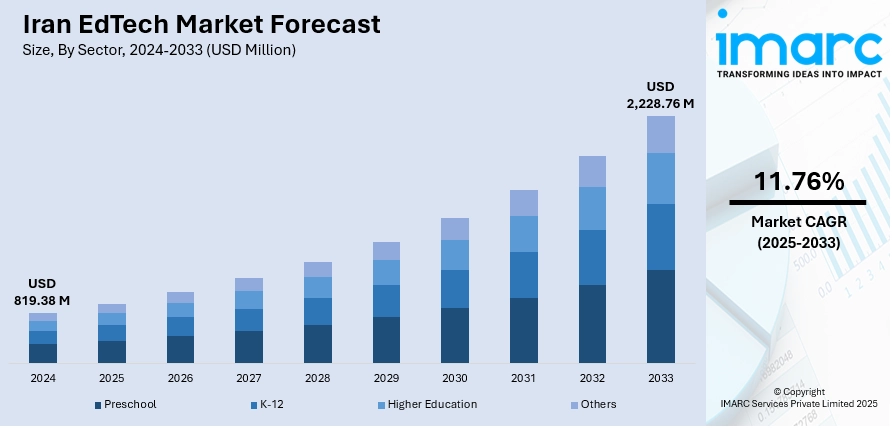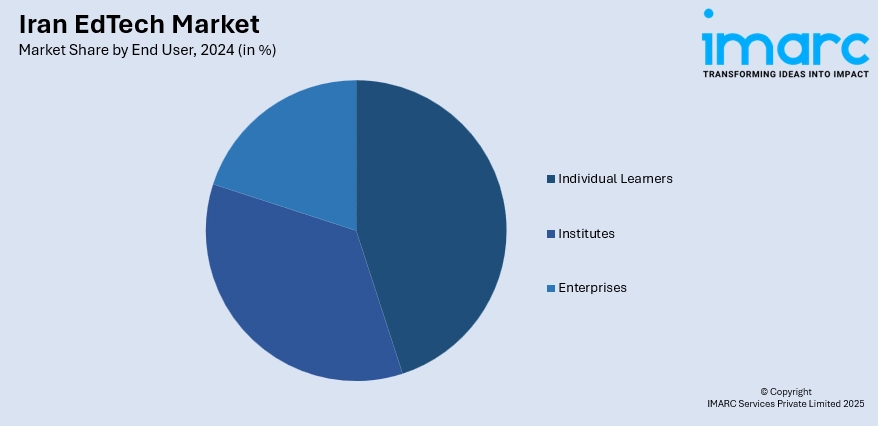
Iran EdTech Market Size, Share, Trends and Forecast by Sector, Type, Deployment Mode, End User, and Province, 2025-2033
Iran EdTech Market Overview:
The Iran EdTech market size reached USD 819.38 Million in 2024. The market is projected to reach USD 2,228.76 Million by 2033, exhibiting a growth rate (CAGR) of 11.76% during 2025-2033. The market is driven by rising demand for remote learning, increased smartphone and internet penetration, a growing youth population, and the need to bridge educational gaps in underserved regions. Local startups and academic institutions are also adopting digital tools, collectively enhancing the Iran EdTech market share.
|
Report Attribute
|
Key Statistics
|
|---|---|
|
Base Year
|
2024 |
|
Forecast Years
|
2025-2033
|
|
Historical Years
|
2019-2024
|
| Market Size in 2024 | USD 819.38 Million |
| Market Forecast in 2033 | USD 2,228.76 Million |
| Market Growth Rate 2025-2033 | 11.76% |
Iran EdTech Market Trends:
Rising Role of AI and Personalized Learning Tools
The incorporation of artificial intelligence (AI) and adaptive learning technologies is a trend in the Iran EdTech market that is on the rise. EdTech startups are integrating AI to create adaptive learning experiences that cater to student performance, engagement habits, and learning preferences. Intelligent platforms provide instant feedback, customized tests, and personalized content suggestions, which improve both student and teacher learning outcomes. With educational institutions looking for effective solutions for handling large student numbers, AI-powered tools are gaining prominence. This trend also fits Iran's general interest in technology-driven development, backed by government research institutions and university collaborations. The continuous adoption of smart systems is a major driver of Iran EdTech market expansion, particularly in urban areas where digital infrastructure is more developed. The position of government intervention in digital education mightily increased, especially in backing the Iran EdTech market growth. For instance, in May 2025, Iran launched a nationwide AI education initiative targeting one million schoolchildren aged 7 to 15. The program aims to provide free, engaging AI training through a dedicated online platform. The curriculum combines theoretical knowledge with practical applications, focusing on making AI concepts accessible and enjoyable for young learners. Additionally, the first phase includes training 100,000 teachers and parents to support the children's learning process. This initiative reflects Iran's commitment to fostering technological literacy and preparing the next generation for the digital future.

To get more information on this market, Request Sample
Increased Government Engagement in Digital Education
Governments are acknowledging the role of digital tools and resources in transforming education systems and improving accessibility. With growing emphasis on digital transformation, government policies are being designed to spur the development and adoption of new educational technologies. This involves the establishment of conducive regulatory environments, investment in digital infrastructure, and the enhancement of digital literacy at all education levels. By supporting collaborations with technology firms and offering capital investment, governments are promoting the development of a viable ecosystem for EdTech innovation. This interaction not only speeds up the implementation of e-learning instruments but also enhances the long-term development and scalability of the EdTech market. For instance, in May 2025, Iran proposed the creation of an international center for digital education at the World Conference on Digital Education 2025. The proposal aims to foster international cooperation in digital learning and develop a unified quality assessment system for digital education. The conference highlighted Iran’s experiences with digital technologies in education, discussing both achievements and challenges, especially with the rise of artificial intelligence.
Iran EdTech Market Segmentation:
IMARC Group provides an analysis of the key trends in each segment of the market, along with forecasts at the country/province levels for 2025-2033. Our report has categorized the market based on sector, type, deployment mode, and end user.
Sector Insights:
- Preschool
- K-12
- Higher Education
- Others
The report has provided a detailed breakup and analysis of the market based on the sector. This includes preschool, K-12, higher education, and others.
Type Insights:
- Hardware
- Software
- Content
A detailed breakup and analysis of the market based on the type have also been provided in the report. This includes hardware, software, and content.
Deployment Mode Insights:
- Cloud-based
- On-premises
The report has provided a detailed breakup and analysis of the market based on the deployment mode. This includes cloud-based and on-premises.
End User Insights:

- Individual Learners
- Institutes
- Enterprises
A detailed breakup and analysis of the market based on the end user have also been provided in the report. This includes individual learners, institutes, and enterprises.
Province Insights:
- Tehran
- Khuzestan
- Bushehr
- Esfahan
- Khorasan
- Others
The report has also provided a comprehensive analysis of all the major provincial markets, which include Tehran, Khuzestan, Bushehr, Esfahan, Khorasan, and others.
Competitive Landscape:
The market research report has also provided a comprehensive analysis of the competitive landscape. Competitive analysis such as market structure, key player positioning, top winning strategies, competitive dashboard, and company evaluation quadrant has been covered in the report. Also, detailed profiles of all major companies have been provided.
Iran EdTech Market News:
- In April 2024, EON Reality launched Iran's first Spatial AI Center, introducing 10,000 tailored XR courses to modernize education and workforce skills. The initiative leverages AI and immersive learning to address Iran's job market needs and skill gaps. Customized content spans fields like renewable energy, robotics, and water engineering. The platform uses AI to analyze and enhance educational strategies. This move is part of EON’s global strategy to democratize knowledge using AR/VR, preparing Iranian youth for a future shaped by AI-driven industries.
Iran EdTech Market Report Coverage:
| Report Features | Details |
|---|---|
| Base Year of the Analysis | 2024 |
| Historical Period | 2019-2024 |
| Forecast Period | 2025-2033 |
| Units | Million USD |
| Scope of the Report | Exploration of Historical Trends and Market Outlook, Industry Catalysts and Challenges, Segment-Wise Historical and Future Market Assessment:
|
| Sectors Covered | Preschool, K-12, Higher Education, Others |
| Types Covered | Hardware, Software, Content |
| Deployment Modes Covered | Cloud-based, On-premises |
| End Users Covered | Individual Learners, Institutes, Enterprises |
| Provinces Covered | Tehran, Khuzestan, Bushehr, Esfahan, Khorasan, Others |
| Customization Scope | 10% Free Customization |
| Post-Sale Analyst Support | 10-12 Weeks |
| Delivery Format | PDF and Excel through Email (We can also provide the editable version of the report in PPT/Word format on special request) |
Key Questions Answered in This Report:
- How has the Iran EdTech market performed so far and how will it perform in the coming years?
- What is the breakup of the Iran EdTech market on the basis of sector?
- What is the breakup of the Iran EdTech market on the basis of type?
- What is the breakup of the Iran EdTech market on the basis of deployment mode?
- What is the breakup of the Iran EdTech market on the basis of end user?
- What is the breakup of the Iran EdTech market on the basis of province?
- What are the various stages in the value chain of the Iran EdTech market?
- What are the key driving factors and challenges in the Iran EdTech market?
- What is the structure of the Iran EdTech market and who are the key players?
- What is the degree of competition in the Iran EdTech market?
Key Benefits for Stakeholders:
- IMARC’s industry report offers a comprehensive quantitative analysis of various market segments, historical and current market trends, market forecasts, and dynamics of the Iran EdTech market from 2019-2033.
- The research report provides the latest information on the market drivers, challenges, and opportunities in the Iran EdTech market.
- Porter's five forces analysis assist stakeholders in assessing the impact of new entrants, competitive rivalry, supplier power, buyer power, and the threat of substitution. It helps stakeholders to analyze the level of competition within the Iran EdTech industry and its attractiveness.
- Competitive landscape allows stakeholders to understand their competitive environment and provides an insight into the current positions of key players in the market.
Need more help?
- Speak to our experienced analysts for insights on the current market scenarios.
- Include additional segments and countries to customize the report as per your requirement.
- Gain an unparalleled competitive advantage in your domain by understanding how to utilize the report and positively impacting your operations and revenue.
- For further assistance, please connect with our analysts.
 Request Customization
Request Customization
 Speak to an Analyst
Speak to an Analyst
 Request Brochure
Request Brochure
 Inquire Before Buying
Inquire Before Buying




.webp)




.webp)












